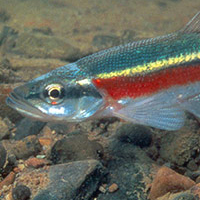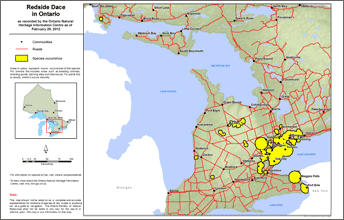Redside dace
Scientific name: Clinostomus elongatus

Cover photo credit: W.N. Roston, AFS Fish Slide Catalog
Status
Endangered
“Endangered” means the species lives in the wild in Ontario but is facing imminent extinction or extirpation.
Date added to the Species at Risk in Ontario List
February 18, 2009
Read the most recent assessment report (PDF)
What it looks like
The Redside dace is a member of the minnow family and reaches up to 12 cm long.
Adults are colourful with a red stripe along the front half of the body and a bright yellow stripe above that extends almost to the tail fin.
The colours intensify during the spring spawning season (May to early June), especially in males. Redside dace have a large mouth and protruding lower jaw that is well suited to feeding on insects hanging on vegetation over water.
Where it lives
The Redside dace is found in pools and slow-moving areas of small streams and headwaters with a gravel bottom.
They are generally found in areas with overhanging grasses and shrubs, and can leap up to 10 cm out of the water to catch insects.
During spawning, they can be found in shallow parts of streams, which are also popular spawning areas for other minnow species.
Where it’s been found in Ontario
Redside dace are found in patches around the Great Lakes Basin, west to Minnesota, south to Kentucky and West Virginia, and east to New York State.
In Canada, Redside dace are found in a few tributaries of Lake Huron, in streams flowing into western Lake Ontario, the Holland River (which flows into Lake Simcoe), and Irvine Creek of the Grand River system (which flows into Lake Erie).
View a larger version of this map (PDF)
What threatens it
Habitat loss and degradation caused by urban and agricultural development are the most significant threats to Redside dace
Development can alter stream flow and shape, cause excessive amounts of sediment to enter the water, result in the removal of streamside vegetation which the species needs for cover and food, and to moderate water temperature.
Action we are taking
Endangered Species and their general habitat are automatically protected.
Recovery strategy
A recovery strategy advises the ministry on ways to ensure healthy numbers of the species return to Ontario.
Read the executive summary (February 18, 2010)
Read the recovery strategy (February 18, 2010)
Government response statement
A government response statement outlines the actions the government intends to take or support to help recover the species.
Read the government response statement (November 18, 2010)
Five-Year Review of Progress
A five-year review reports on progress made toward protecting and recovering a species, within five years of publishing a species’ government response statement.
Read the report on progress towards the protection and recovery of 13 species at risk, including Redside Dace (2015)
Habitat protection
A habitat regulation defines a species' habitat and many describe features (e.g., a creek, cliff, or beach), geographic boundaries or other unique characteristics.
Read the regulation (July 1, 2011)
What you can do
Report a sighting
The Ministry of Natural Resources and Forestry tracks species at risk such as the Redside dace. Report a sighting of an endangered animal or plant to the Natural Heritage Information Centre. Photographs with specific locations or mapping coordinates are always helpful.
Volunteer
Volunteer with your local nature club or provincial park to participate in surveys or stewardship work focused on species at risk.
Be a good steward
- Private land owners have a very important role to play in species recovery; if you find Redside dace in a watercourse on or adjacent to your property, you may be eligible for stewardship programs that support the protection and recovery of species at risk and their habitats.
- Invasive species seriously threaten many of Ontario’s species at risk; to learn what you can do to help reduce the threat of invasive species, visit:
- Farmers and land owners can help improve fish habitat and keep Ontario’s water safe and clean by maintaining natural vegetation next to creeks and rivers, and keeping pollution and soil from washing into Ontario’s streams and rivers; For more information about programs and funding assistance for eligible land owners visit the Ontario Soil and Crop Improvement Association website.
Report illegal activity
Report any illegal activity related to plants and wildlife to
Quick facts
- Redside dace often use nests built by other fish species and leave it up to the other species to guard the nest and eggs.
- Redside dace are the only fish in Canada with the ability to jump out of the water to eat.
- Redside dace do not usually live more than four years; females are typically larger than males.
- Studies are underway to gain a better understanding of key habitat characteristics that are necessary to promote successful reproduction.
